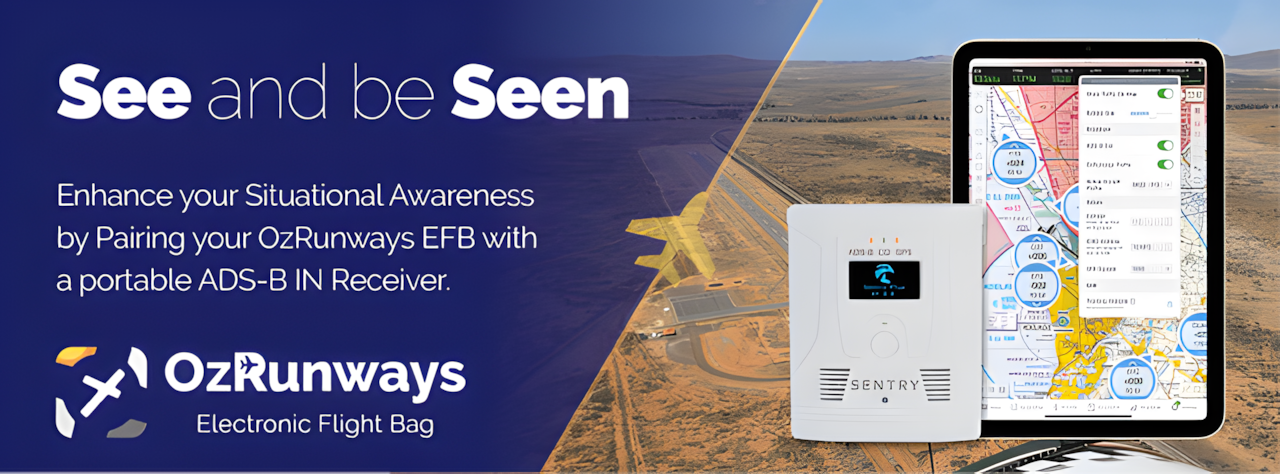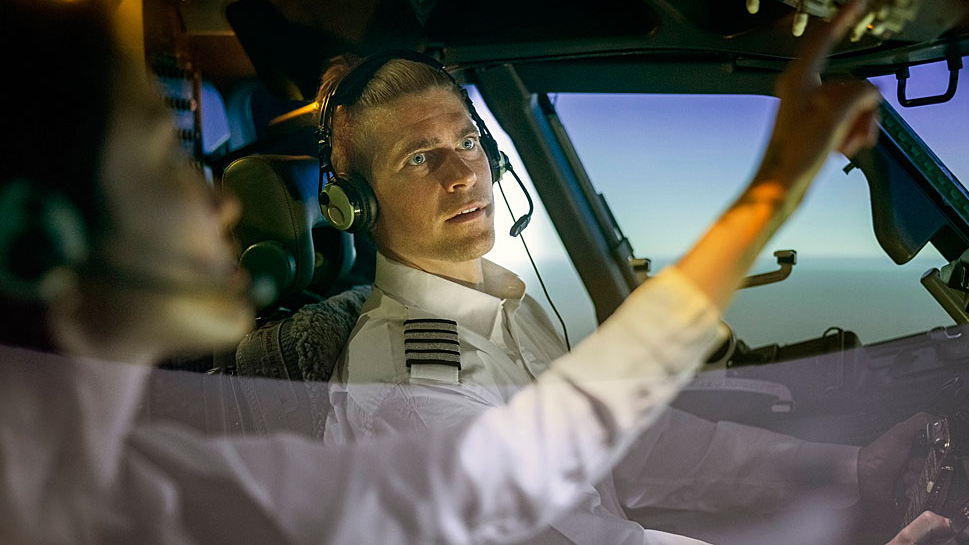Welcome to Week 3 of National Safety Month 2025
Proudly Sponsored by:

OzRunways Electronic Flight Bag makes navigation easy with unsurpassed situational awareness. Meaning you can spend less time folding paper and more time enjoying the greatest show on earth: the view through the cockpit window.
What exactly is Automatic Dependent Surveillance-Broadcast (ADS-B)?
ADS-B is a broadcast surveillance system that differs from traditional transponders by sending out continuous signals (at least once per second) without needing to be interrogated by another unit first. These signals are rich with information including the aircraft’s identity (callsign), precise GPS location, altitude, and velocity.
ADS-B OUT
Means others can SEE YOU. An aircraft transmits an ADS-B signal OUT into the air.
ADS-B IN means you can SEE OTHERS
ADS-B receiver equipped aircraft receive the signal IN.
ADS-B devices such as the Sentry work independently of the cellular network and don’t rely on a ground-based receiver. Plus, they’re supported by every OzRunways EFB subscription! Hands down the number one solution for nearby traffic awareness is through a portable ADS-B IN device!
By pairing your OzRunways EFB with a portable ADSB-IN Receiver you will be able to see RPT traffic approaching, as well as other traffic in the busy training area and increase your overall situational awareness.
For more information visit: https://www.ozrunways.com/au/products/adsb/
FLIGHT PHASE: CRUISE
Once an aircraft levels off into cruise, many pilots might feel a sense of comfort—away from the demands of take-off and before the challenges of approach. Yet, the cruise phase is far from a time to relax. It is where situational awareness becomes both critical and tested. Unlike other phases of flight, the apparent calmness of cruise can lead to complacency, distractions, or missed cues that may compromise safety.
Situational awareness is about more than simply “looking out the window.” It’s the active, continuous process of perceiving what’s happening around you, understanding its meaning, and anticipating what may happen next. From spotting conflicting traffic in a busy circuit to recognising performance differences between aircraft types, awareness is what keeps the skies safe and predictable.
This week, we explore how subtle lapses—such as missing something obvious (the “Invisible Gorilla” effect) or failing to detect nearby traffic—can creep in during cruise. We also highlight practical strategies to stay ahead of the aircraft, make yourself visible to others, and manage the complexities of mixed traffic environments.
👉 Cruise may reduce the manoeuvring demands, but increases the importance of an active work cycle of tasks to maintain full situational awareness
What is Situational Awareness?
Seeing, Understanding, Anticipating and Acting
CASA, through their Safety Behaviours Resource Booklet 6, defines situational awareness as:
- Comprehension – understanding what that information means.
- Projection – thinking ahead to what is likely to happen next.
- Perception – noticing what’s happening around you (traffic, weather, aircraft performance).
Put simply: situational awareness means
- knowing what has happened
- what is happening now, and
- what could happen next.
In Practice
Imagine you’re in the circuit:
- You see another aircraft turning base (perception).
- You realise they’ll likely reach final at the same time as you (comprehension).
- You plan to extend your downwind to maintain safe spacing (projection).
This three-step loop is always running in the background when you fly. The stronger your awareness, the better prepared you are for the unexpected.
The Invisible Gorilla – Hidden in Plain Sight
You’re cruising on a calm afternoon, eyes moving between the horizon and your instruments. Off to the right, another aircraft is in view—but no apparent threat. You continue to monitor it, but with no immediate conflict you turn your attention back inside the cockpit. A second later, another aircraft is suddenly much closer, crossing ahead of you, forcing a rapid correction.
The truth, is it was always there. You missed the obvious, and you didn’t process it as the real threat.
That’s inattentional blindness—the “Invisible Gorilla” effect. Our brains can filter out information that doesn’t seem relevant at the time, even if it’s critical. In flying, that can mean missing the significance of traffic, cues in the circuit, or even a clear radio call.
💡 When you spot traffic and think “no threat,” do you include that in a focused scan—or do you move on and risk being surprised?
What’s one good technique to avoid such surprises!
See, Don’t Just Look
We often say “keep a good lookout”—but what does that really mean?
Looking is passive. Seeing is active. It’s about deliberate scanning, breaking the sky into sectors, and pausing long enough for your eyes to detect movement.

💡 Tip: Effective scan patterns + effective listening = your best defence against mid-air conflicts.
⚠️ What if the Invisible Gorilla was Invisible until it’s too late?
Let’s Understand Situational Awareness Better
CASA, in their Safety Behaviours: Human Factors for Pilots resource booklet, reminds us that situational awareness is about more than “looking out the window.” It’s about keeping the big picture — knowing what’s happening now, and what might happen next.
But awareness isn’t automatic. Certain pressures can quietly erode it, and there are tell-tale signs when it’s slipping away.
⚠️ Factors That Can Reduce Situational Awareness
- Target fixation
- Degraded attention
- Fatigue or stress .
- Task overload (saturation) or underload (complacency during quiet phases).
- Expectation bias. – convincing ourselves what we expect to see is what is actually happening
- Degraded environments — weather, visibility, system issues.

Think back: Have you ever noticed your “big picture” shrinking under one of these pressures?
🔎 How Do You Know You’ve Lost It?
Loss of awareness is sneaky. CASA points to cues like:
- Conflicting or ambiguous information.
- Feeling confused or overloaded
- Making slips or errors.
- Fixating on one task, forgetting the rest.
- Vague or missed radio calls.
- Non-compliance with limits or SOPs.
- Ignoring contradictions or discrepancies.
- Missing a navigation checkpoint.
💡 Quick self-check in flight: Am I ahead of the aircraft, or chasing it?
Building situational awareness: “It Starts Before You Fly”
Plan the work, work the plan.
Pre-brief who does what in high-workload phases (join/circuit, descent/approach). Single-pilot? Brief passengers to be extra eyes and to speak up.
Protect interrupted tasks.
When anything breaks your flow, leave a breadcrumb you can’t miss: bug a heading/altitude, set a countdown timer, park your finger on the checklist line, or place a “pause” marker on the throttle/yoke. Then resume exactly where you stopped.
Think in “what-ifs.”
Project a few minutes ahead and set simple gates: If weather/spacing/fuel drifts to X, I’ll do Y. Keep visual illusions and missing/low-quality info on your mental radar.
Maintaining situational awareness “Staying Sharp in the Air”
Keep everyone in the loop.
Use all available services; share intentions and changes early. If you sense SA slipping—yours or a crewmate’s—call it out.
Control your attention.
Don’t fixate. Cycle a simple scan: Aviate → Navigate → Communicate, then repeat.
Verify the picture.
Continuously compare reality to plan (track, altitude, fuel). Hold the big picture while you check the small stuff—and always cross-check.
Planning Ahead: The Pre-Flight Briefing
Does it ring a bell! “It Starts Before You Fly”
It’s a good time to connect back to what we discussed in Week 1 — Pre-flight.
Situational awareness doesn’t begin in the air; it begins well before take-off. This week, as we focus on maintaining awareness in cruise, let’s revisit how thorough pre-flight preparation sets the tone for every phase of flight.
Tools like NOTAMs, the ERSA, and airspace charts aren’t just background reading — they are critical pieces of the situational awareness puzzle. By identifying hazards, understanding aerodrome procedures, and knowing the airspace you’ll be operating in, you reduce the risk of surprises and lighten your workload in the cockpit.
Why This Matters Now
Many incidents in Australian airspace have their roots in gaps during the planning stage.
- A missed NOTAM
- An overlooked airspace restriction, or
- Unfamiliarity with circuit procedures
These can all lead to high workload and reduced awareness in flight.
Planning ahead not only helps you stay ahead of the aircraft — it helps keep the entire airspace system safe.
An Interview With ATC – Understanding Controlled Airspace
This week in the enroute or cruise phase of flight we will look at airspace, not particularly Class G airspace which most of us fly in, but associated controlled airspace, knowing how to navigate clear of it, planning and knowing the status and requirements for active controlled airspace awareness, understanding the job of the controllers and how you can remain vigilant to approach points, traffic mix and the communications with ATC that will keep everyone safe and separated.
Members are encouraged to watch the video below with Neil Schaefer, RAAus Acting Head of Safety and Head of Training Development, and Scott Nugent, President of Civil Air, Australia’s Air Traffic Control Union and Professional Association, who will share insights into current trends in Australian airspace, the risks these create for pilots, and practical ways to overcome them.
PARTICIPATE TO WIN!
Read and watch the content above, then enter your details and the hidden codeword provided within the ‘An Interview With ATC – Understanding Controlled Airspace‘ video to enter our Week 3 prize draw!
YOU COULD WIN ONE OF THE FOLLOWING PRIZES*
FIRST PRIZE: GDL 50 Portable ADS-B Receiver + OzRunways Subscription
Sponsored by Garmin and OzRunways
Valued at $1,600
SECOND PRIZE: iPad Mini 64GB + OzRunways Subscription
Sponsored by RAAus and OzRunways
Valued at $1,298
THIRD PRIZE: FLYTE Sunglasses
Sponsored by FLYTE
Valued at $245



*Applicants must hold a current Flying Membership or Non-Flying Membership in order to win the first prize.
*Terms and Conditions apply
